Are you a Quiet Speculation member?
If not, now is a perfect time to join up! Our powerful tools, breaking-news analysis, and exclusive Discord channel will make sure you stay up to date and ahead of the curve.
I cannot escape. As a Denver resident, I am used to unusually unseasonal weather usurping usual undertakings. Why, as a lad I suffered snow at summer camp more than once. Even in July. And an unrelated time, it snowed in August. While thinking of snow on the pines is pleasant and all, it has little to do with Modern. Except that's not true, because snow is everywhere. Not just because it actually did snow here yesterday, but because, for some reason, Bant Snow is becoming omnipresent. Or appears to be, anyway. Those I encounter online further the complaint and decry their observation that they can never escape Snow, especially when Uro constantly does.

The question that must then be considered is why. Why is always the most important question. Is the Snow shell really impermeable? Is Modern due for an ice age? Or is it simply that Snow is visible and successful because it is popular? The definitive, absolutely incontestable answer is yes. Snow is a good deck and will be a strong contender in Modern for the foreseeable future, and indeed will remain so until Wizards prints something to make snow a drawback. However, that is a minor consideration compared to the inescapable fact that players just want to play in the snow. Popular adoption, regardless of actual power, ensures that a deck will perform in the metagame. Modern will have Snow for a long time thanks to power and popularity. Ultimately, the haters need to chill. Snow is good, but only because it's getting help.
Snow Over Everything
That the Bant Snow shell (Acrum's Astrolabe, Ice-Fang Coatl, Uro, Titan of Nature's Wrath) is robust, adaptable, and adoptable shouldn't be controversial at this point. Hang anything off that shell, and it's pretty much guaranteed to function. This appears to be the crux of player dissatisfaction with the deck, though it should be noted many players are simply never happy.
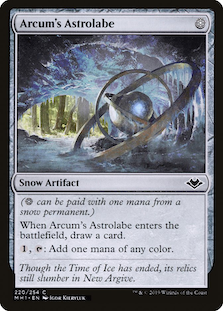 In this specific case, I do sympathize. Snow carries a lower opportunity cost than anticipated. Astrolabe is a far better card simply because I didn't realize how well it integrated snow into decks. Mana-fixing artifacts don't generally see play outside of artifact combo decks because they're tempo-negative and the Modern manabase makes playing many colors relatively easy. Prophetic Prism sees play in Pauper Tron, but that's about it. What I failed to grasp was Ice-Fang Coatl's appeal is so great that any price is worthwhile. The only way to have enough snow permanents to make Coatl good is to run lots of basic lands, which runs counter to how midrange/control decks are built. Astrolabe being one mana and a cantrip greatly reduces burdens on the manabase, and makes everything else possible.
In this specific case, I do sympathize. Snow carries a lower opportunity cost than anticipated. Astrolabe is a far better card simply because I didn't realize how well it integrated snow into decks. Mana-fixing artifacts don't generally see play outside of artifact combo decks because they're tempo-negative and the Modern manabase makes playing many colors relatively easy. Prophetic Prism sees play in Pauper Tron, but that's about it. What I failed to grasp was Ice-Fang Coatl's appeal is so great that any price is worthwhile. The only way to have enough snow permanents to make Coatl good is to run lots of basic lands, which runs counter to how midrange/control decks are built. Astrolabe being one mana and a cantrip greatly reduces burdens on the manabase, and makes everything else possible.
In fact, this point about opportunity cost is the real benefit and problem with snow. All the pieces are cantrips, and cantrips make every deck they're in run better. While Aerial Responder-style cantrips provide card selection and are obviously powerful (just ask Legacy), Coatl and Astrolabe simply increase velocity. This doesn't mean much in a vacuum, but when a large portion of the deck boosts velocity, the deck is just runs smoother. The churning cards, especially when there's additional benefit to playing them, simply push the deck along and, eventually, through the opposition. Just as a glacier gradually shapes the land, Snow's cantrips-with-upside shape the deck.
Case in Point
Let us consider an example. Jund is a deck built to grind by maximizing the impact of each card. Jund doesn't win via quantity, but quality, and so doesn't have many cantrips. Bant Snow has many good cards, but many are only good in context. Stoneforge Mystic is only really worthwhile when the equipment is also great and vice versa. However, the matchup is far easier for the Bant player than the Jund ones. I wouldn't say that it's favorable, but that there's more forgiveness for Bant. And that's the critical factor.
S'no Reason to Panic
 Consider this game that I observed a bit over a month ago. The Jund player, who I shall call Edward to prevent public humiliation (though not private; he knows what he did), was playing against Bant online, and despite having multiple opportunities to win the game, failed to do so. His opponent didn't do much better on that front, and was in some ways worse about sealing the deal. It didn't matter because Edward's deck punished him, where the opponent's was forgiving. The culprit: cantrips healing all wounds.
Consider this game that I observed a bit over a month ago. The Jund player, who I shall call Edward to prevent public humiliation (though not private; he knows what he did), was playing against Bant online, and despite having multiple opportunities to win the game, failed to do so. His opponent didn't do much better on that front, and was in some ways worse about sealing the deal. It didn't matter because Edward's deck punished him, where the opponent's was forgiving. The culprit: cantrips healing all wounds.
Going into turn three, the game was fairly even. Bant had out Astrolabe, with a fetchland, Teferi, Time Raveler, and Coatl in the graveyard, and was at 14 life from fetching and being hit by a 5/6 Tarmogoyf. Bant played their third land and Uro'd back to 17, dropped a tapped Breeding Pool, and passed. Edward had gone first, Inquistioned away the Teferi, then played Goyf, had Pushed the Coatl during the last attack, and then played Wrenn and Six. In other words, he held a solid lead.
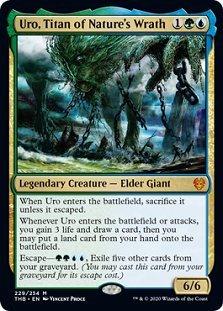 On his turn four, he was faced with the choice of either playing a freshly-drawn Scavenging Ooze and eating Uro or playing Bloodbraid Elf. Ooze is less pressure and card advantage, but ensures that Uro is gone. Elf is more mana-efficient and provides a burst of card advantage. He chose Elf and cascaded into Liliana of the Veil. After upticking and attacking for 8, he passed, confidant of victory.
On his turn four, he was faced with the choice of either playing a freshly-drawn Scavenging Ooze and eating Uro or playing Bloodbraid Elf. Ooze is less pressure and card advantage, but ensures that Uro is gone. Elf is more mana-efficient and provides a burst of card advantage. He chose Elf and cascaded into Liliana of the Veil. After upticking and attacking for 8, he passed, confidant of victory.
However, his opponent drew another fetchland and then had enough fodder to escape Uro, and was left with two untapped lands after the ability resolved. Edward downticked Liliana on his turn and finally played the Ooze, only to have it Spell Snared. Goyf got Pathed, and the opponent untapped into Teferi, Hero of Dominaria. Over a turn cycle, he'd gone from well ahead to falling behind because where he was maximizing individual value, his opponent's cantrips let him maximize long-run value. And all could have been avoided if he'd just eaten the Uro. Instead, his opponent Uronated until Edward couldn't take anymore.
It Gets Worse
In the subsequent game, Edward suffered further indignities as he ground as hard as possible with his opponent, but could never get ahead. When every card trades with every 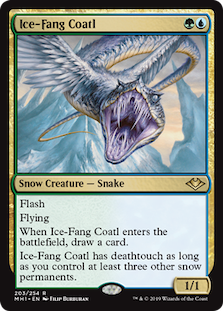 other card, but one side gets to draw an extra one, they're going to come out on top. Lightning Bolt trades favorably on mana with Coatl, but in this context, only cards matter.
other card, but one side gets to draw an extra one, they're going to come out on top. Lightning Bolt trades favorably on mana with Coatl, but in this context, only cards matter.
However, Edward had chances to put the game away with either a better Liliana ultimate than he did, or by not playing into a telegraphed Supreme Verdict. I even yelled that the Verdict was incoming, but he didn't believe me. On the other side, the opponent threw away a lot of value by mistiming Veil of Summer and Archmage's Charm, exposing Teferis (both kinds) to attack, and not swinging when the opportunity arose. It didn't matter. The number of cards that the opponent churned through made up for all that hemorrhaged value. Thus, he left Edward Snowed-in, trapped in the Russian winter.
Skating Through Modern
I believe this forgiveness is the beauty, appeal, and rage-target concerning Bant Snow. It's not that the deck is inherently easy to play thanks to all the cantrips. Rather, the type of cantrips in Bant help smooth everything over. Legacy is a format about cantrips, and it's not an easy format. Card selection means players have more decisions to make. This gives them more opportunities to outplay the opponent. Or screw up. However, either doesn't feel unfair. Losing because the opponent was just better or you messed up is something players can respect.
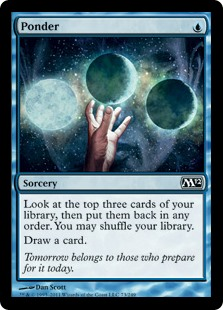 However, velocity cantrips aren't card selection. There's no decision to make beyond playing the card. Play Astrolabe, draw a card; simple. They therefore feel lower-skill. This impression is compounded by velocity cantrips being functionally deck grease. Brainstorm is like engineering new tracks, but Coatl simply greases the existing tracks, making the train more efficient. The deck becomes more forgiving of mistakes because its velocity translates into momentum, which can plow through hiccups that would derail a less-forgiving deck.
However, velocity cantrips aren't card selection. There's no decision to make beyond playing the card. Play Astrolabe, draw a card; simple. They therefore feel lower-skill. This impression is compounded by velocity cantrips being functionally deck grease. Brainstorm is like engineering new tracks, but Coatl simply greases the existing tracks, making the train more efficient. The deck becomes more forgiving of mistakes because its velocity translates into momentum, which can plow through hiccups that would derail a less-forgiving deck.
In my earlier example, Edward and his opponent were making roughly comparable mistakes. However, Edward only had the cards he drew each draw step to work with, whereas his opponent kept cantripping. This amplified each of Edward's mistakes until he was max-punished by losing the match. Jund is unforgiving, and even masters can't overcome this problem. By contrast, in the Bant shell, Astrolabe smooths out sub-optimal mana, Coatl forgives slow draws, and Uro forgives throwing away cards. This generosity engenders bitterness from players whose decks are not so benevolent.
Remember to Have Fun
And this brings up the real reason that snow appears to be everywhere: it's fun. Playing a forgiving deck is a lot more fun than the alternative. Ravager Affinity was the most objectively powerful deck of its era, but it was also a very forgiving deck. Arcbound Ravager was known as the Fairy Godmother because it was make every dream come true, no matter how undeserving the godchild actually was. Keep a suboptimal hand or fail to get full value out of everything? Just draw and cast Ravager and everything is well again.
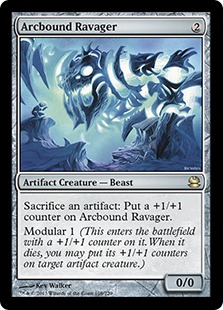 Jund is a deck that many players aspire to because it feels awesome to just Jund-out an opponent. But that is tempered by the heartache of learning the deck. Tarmogoyf is not as forgiving as Ravager used to be, and can't solve all problems. Jund can be a temperamental prima donna, and requires consistently high-level play. If pilots don't maximize value at all times, sequence correctly, or really believe, Jund's not going to sing for them.
Jund is a deck that many players aspire to because it feels awesome to just Jund-out an opponent. But that is tempered by the heartache of learning the deck. Tarmogoyf is not as forgiving as Ravager used to be, and can't solve all problems. Jund can be a temperamental prima donna, and requires consistently high-level play. If pilots don't maximize value at all times, sequence correctly, or really believe, Jund's not going to sing for them.
Meanwhile, the Bant Snow shell is more mellow. It fits in anywhere, lets players do what they want, and then helps them accomplish it even when they can't really do it themselves. Add to that players generally liking gaining value, playing big spells, durdling, and winning via crushing the opponent. Of course Bant's numbers are inflated.
Uro Doing It Wrong
The final problem is that players don't seem to understand the deck. The general goal of decks running the Bant shell is to snow opponents under with value. Uro is a critical part of that plan, and for the most part is the primary win condition. At the more extreme end, it's the only win condition. It's getting to the point of Uroversality. Again, it combines a lot of things that players love in one place. It's natural to gravitate towards the new and powerful thing that gives you everything you want, and a win. But there are ways to neuter the strategy.
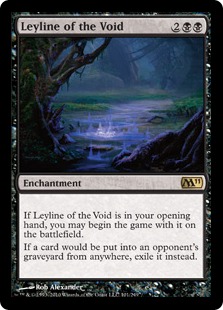 As I keep harping, Uro is worthless against graveyard hate. A single Surgical Extraction can render Temur Snow Control decks unable to win. However, for reasons that I bitterly cannot understand, players won't play graveyard hate in sufficient quantity, and allow Uro players to get away with this weakness. Uro is a house of a card, but the problem with a house of cards is fragility.
As I keep harping, Uro is worthless against graveyard hate. A single Surgical Extraction can render Temur Snow Control decks unable to win. However, for reasons that I bitterly cannot understand, players won't play graveyard hate in sufficient quantity, and allow Uro players to get away with this weakness. Uro is a house of a card, but the problem with a house of cards is fragility.
Perhaps they're getting away with this weakness because opponents undervalue Uro. Failing to deal with Uro via hate is the most obvious example, but more generally, players just let Uro crush them. I have seen lots of players refuse to use removal, be it counterspells or creature removal, on Uro because of their fear of giving up "value" to escape. As a result, they just sit there and drown under a stream of damage, lifegain, and cards while Uro does its thing. It's critical to choke the stream so the opponent's deck bursts under its own weight. Yes, Uro can come back, but not for a turn or more, and it's better for opponents to have Uro returning from the graveyard than attacking them. Just use the removal.
Uro-versal Constant
Despite the frustrating wailing of players, there's little chance that the snow will thaw, or that Modern will flush Uro out of its system any time soon. There's too much that players like about the snow shell and Uro specifically, and it's not like there isn't counterplay. Players need to get over the fear and deal with the problem before Modern becomes an inflamed Uronary tract.




So something that I just thought of that I have yet to encounter (because it’s only a paper magic concern), is whether or not there is a default assumption (under the tournament floor rules) for the order that simultaneous triggers from the same player go on the stack. In other words, if I have a Surgical Extraction in my hand, and my opponent has enough mana to cast and then immediately escape an Uro (or Kroxa), and they *don’t* declare the order they are resolving the triggers, I may or may not be able to Surgical the titan. It’s a weird (but relevant, I think), rules corner case. Any thoughts?
So the short answer is that under the rules the trigger’s controllers must select and specify the order. If they fail to do so, this must be corrected and specified.
For the real meat of your question, that’s an interesting area. To the best of my knowledge, and I should remind you I’m not a real judge (I just play one for FNM), there is no assumed order, though in general judge instructions are to default to the interpretation favorable to the trigger’s controller. Thus if there’s a question, they’re likely to not give you the ruling you want if there’s ambiguity.
However, actual play actions take precedence over assumptions, particularly at comp REL or above. So if your opponent plays said titan, moves it to the graveyard and then tries to resolve the other trigger, they’re considered to have specified the action by demonstration, and your plan will work. I don’t know any real judge that will let them take back such an action because they demonstrated the effects of the triggers in an order. If they do the action first then move the titan to the graveyard, they’re out of luck. Now, in my experience in paper most players will resolve the ETB value trigger first by default action, so it’s unlikely to ever work in the situation you’re asking about. However, there will be a few times when it will happen, so you need to keep your eyes open.
If you are worried about revealing the SE (thus alerting your opponent to your plan and incentivizing them to stack favorably) by asking opponents to specify the order of their triggers, I think there are some sneaky ways you could go about fishing for your desired outcome. For what not to do, maybe something like, “hang on, how are you ordering your triggers? Because I might have a response.”
I think feigning confusion would work better, e.g. putting your hand down and saying “sorry let me see if i understand this: he’s going to die, but then you will get to draw a card and gain life right?” When your opponent inevitably confirms, they are locking themselves into the order demanded by Surgical and you can say “okay, then I’ll respond to the draw a card trigger now that Uro is in the graveyard.” Many opponents probably won’t even feel tricked!
I love the look of the 4c variants – Bant control version (without the Stoneforge package) plus red for Wrenn… and Blood Moon out the board to give the Astrolabe-decriers something to really moan about ;0p
It’s odd to me that 4c doesn’t see as much play as Bant or Temur. Wrenn’s a fun card in Jund so I might be biased here, but she seems too good to not play. Getting back fetches would be helpful for fixing when you don’t have Astrolabes (or when Karn turns them off), and for fetching Mystic Sanctuary later on. Plus she works well with Jace Brainstorms (the hidden extra cantrip in the deck). White obviously has Teferi and Path even without running Stoneforge, so combining Bant and Temur looks like the way to go imo.
From what I can tell, the problem is (ironically) mana and durdle. Astrolabe smooths out a lot of the problems with playing a 3-color manabase with a lot of basics, but can’t eliminate them entirely. The mana can be awkward to the point of lethality in Temur and Bant as-is, so mixing them is a greedy proposition.
Then there’s the issue of space. Snow that isn’t Snowblade tends to be very durdly, Temur more than Bant. Wrenn is a good card for helping mana, but doesn’t do much by itself. What you’re proposing is a deck with a whole lot of control, and few ways to actually win. I wouldn’t rely on opponent’s conceding as a win condition.